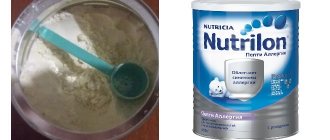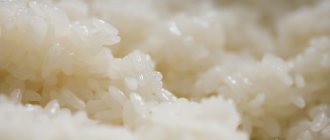hypoallergenic nutrilak
Allergy to formula is a fairly common occurrence in bottle-fed babies. This is due to numerous factors, the main one of which is intolerance to individual components of this product. In children under one year of age, the most common food allergen is cow's milk protein, and since the vast majority of infant formula is made from whey or cow's milk, an allergy to the mixture develops. For most mothers, the salvation from this type of allergy is specially developed hypoallergenic mixtures. Unfortunately, some mothers, after the start of production of hypoallergenic formulas, stop breastfeeding, transferring him to artificial feeding with these breast milk substitutes. However, this should not be done, since breast milk will always be better than any, even the safest hypoallergenic formula. An allergy to breast milk can develop only if the nursing mother consumes foods prohibited for consumption during this period (raspberries, strawberries, eggs, cocoa, chocolate, etc.). Therefore, if your baby develops an allergy while breastfeeding, you should not stop breastfeeding, you should just stick to a hypoallergenic diet. To prevent an infant from developing an allergy to the formula, the diet should be selected in accordance with the baby’s current immune status. In addition, the pediatrician observing the child must take into account the family history, and if at least one of the parents has any type of allergy, the risk of developing an allergy to the formula in the child increases many times. For such children, special formulas have been developed based not on milk protein itself, but on its hydrolyzate. Allergy to formula - how to determine? If your baby develops a skin rash, you should contact the baby’s primary care pediatrician to clarify whether the rash is actually of an allergic nature. Then, together with the doctor, it is necessary to exclude contact dermatitis (possible allergic reaction to cream, diapers, baby laundry detergent), which occurs exclusively at the site of contact of the baby’s skin with the provoking allergen. After this, allergies to foods and medications are excluded. After completing all the above-described manipulations, you can begin to think that a bottle-fed child most likely reacts to cow’s milk proteins. How does an allergy to formula manifest in a child: diarrhea, enteritis, constipation, vomiting, regurgitation, intestinal colic, shortness of breath, dermatitis, skin rash Allergy to formula - what to do? If the baby has allergic manifestations to the mixture, there are several options to choose from, and which one to choose depends on the severity of the symptoms: - If the baby, in addition to skin rashes, has excess body weight and regurgitation, this is overfeeding and the daily and one-time feeding volumes should be reduced to the recommended amounts. given age doses. In the case when the baby is already accustomed to eating a lot, the mixture should be made less concentrated, i.e. just dilute it. This will significantly reduce the load on the digestive tract, the processes of fermentation and putrefaction in the intestines will decrease, the mixture will be digested much better and allergic manifestations will also decrease accordingly - If the skin rashes are moderate or very minor, you can simply try changing one mixture to another, and preference should be given fermented milk mixtures or mixtures containing probiotics. The use of such mixtures creates all the favorable conditions for the proliferation of beneficial lactic acid bacteria in the baby’s intestines, making the mixtures much easier to digest and cause allergies in isolated cases - It is necessary to completely exclude the provoking allergen from the child’s daily diet (in this case, cow’s milk protein). This should be done if the two options described above did not help cope with allergic manifestations or if the allergy symptoms are very pronounced. If the child is allergic to the formula, then you can eliminate the provoking allergen (cow's milk protein) in the following ways: - Replace the formula containing cow's milk with goat milk mixture. This option is the most preferable, since goat milk proteins are complete animal proteins and are absolutely not inferior in nutritional value to cow milk proteins. At the same time, the structure of goat's milk proteins is noticeably different from cow's milk proteins, which is an alternative option in the case when a child is allergic to cow's milk protein. Throughout the first year of life, adapted formulas based on goat's milk can be used as the child's main diet. However, unfortunately, some children are also allergic to these formulas - Replacing the formula based on cow's milk with a special soy formula. This used to be a common option (before the advent of goat's milk formulas), but is now less preferred. However, it is soy mixtures that are used to feed babies with allergies to both cow’s and goat’s milk, since the structure of plant proteins differs significantly from animal ones. Unfortunately, soy protein has less nutritional value and is somewhat less digestible and absorbable. In addition, soy formulas also differ far from being for the better in taste compared to milk formulas. The likelihood of developing an allergy to soy formula is about 15% - The third and final option is to permanently replace the cow's milk based formula with a medicated hypoallergenic formula. For many children, this option is the most preferable. Transferring the baby to another formula should be done gradually over a period of five to fifteen days. This should be done even in the event of an allergic reaction, since the baby’s body must gradually get used to the new product in order to avoid digestive breakdown, bowel disorders, or simply refusing to use the new mixture. Rice milk is another way out of this situation. If the mother does not have (or has run out of) her milk or the child is allergic to formula milk, both cow and soy protein, there is only one solution left - to feed the baby with macrobiotic rice milk and formulas made on its basis. As in soy-based formulas, rice milk also lacks some vital fats, the deficiency of which will have to be replenished with the help of special additives introduced into the child's diet. Hypoallergenic formulas Despite the fact that these formulas are called hypoallergenic and are widely advertised in terms of They are absolutely harmless to use, and the mother can easily choose them even without a corresponding doctor’s prescription - these mixtures are not intended for the treatment of children with an allergy to cow protein! The basis of hypoallergenic mixtures is a partial protein hydrolysate, in other words, the mixture contains peptides that can cause the development of various allergic manifestations in children. If your baby has already been diagnosed with a milk allergy, this formula is definitely not suitable. Preventive hypoallergenic formulas are prescribed by a doctor as starter formulas for children who are at increased risk of developing an allergy to cow's milk protein. Also, these mixtures serve as a kind of start when transferring the baby to constant artificial feeding. The following hypoallergenic mixtures have proven themselves well: Humana GA, NAN hypoallergenic, Similak GA, Nutrilon GA, Nutrilak GA, Frisolak GA, Combiotic 2 and Hipp GA. In case of severe allergies, the child is transferred to the elemental mixture Nutrilon Amino Acids, which contains a set of amino acids instead of protein. This mixture cannot cause allergies under any circumstances. The elemental mixture Nutrilon Amino Acids is the final step in choosing a mixture for a child with allergies.
Source: https://vlanamed.com/allergiya-na-smes/ Encyclopedia of Diseases ©
Nutrilak hypoallergenic milk formula 350g from 0 months
A hypoallergenic mixture based on partially hydrolyzed whey proteins is intended for dietary preventive nutrition of children at risk of developing food allergies from the first days of life.
Allergic diseases are associated with the state of the intestinal microflora and immune system. Bifidobacteria and lactobacilli help improve the state of intestinal microbiota and immunity in children on mixed and artificial feeding.
Nutrilak Premium Hypoallergenic – triple protection against allergies.
- Unique lactobacilli L. rhamnosus LGG - probiotic No. 1 - the most effective and safe for children from birth for the treatment and prevention of atopic dermatitis and eczema.
- Bifidobacteria B. Lactis BB-12 maintains the balance of beneficial microflora in the intestines and stimulates the immune system.
- Partially hydrolyzed whey protein has a 100,000 times reduced antigenicity compared to milk protein.
The mixture contains important components necessary for full development:
- DHA (Omega-3) fatty acids - for brain development and maintaining visual acuity.
- Prebiotics (GOS) – promote the growth of healthy intestinal microflora.
- Nucleotides are necessary for the formation of the immune system and the maturation of the gastrointestinal tract.
- Lutein - to protect the baby's retina.
- Adapted fatty acid composition with natural milk fat without palm and rapeseed oil - close to breast milk, easily digestible, promotes comfortable digestion and regular soft stools.
Without GMOs, preservatives, dyes and flavors.
BABYFRIENDLYINGREDIENTS - Specially selected safe ingredients for baby food from the world's best manufacturers
Ingredients: maltodextrin, milk sugar (lactose), vegetable oils (sunflower high oleic, soybean, coconut), whey protein hydrolysate, milk fat, corn starch, emulsifiers (esters of glycerol and citric acid and fatty acids, mono- and diglycerides of fatty acids). acids), minerals (potassium phosphate, calcium carbonate, magnesium chloride, sodium chloride, calcium phosphate, iron (II) sulfate, zinc sulfate, copper sulfate, manganese chloride, potassium iodide, sodium selenite), galactooligosaccharides, fish oil (source of docosahexaenoic acid DHA and eicosapentaenoic EPA acids), vitamin complex (L-ascorbic acid, DL-alpha-tocopherol acetate, nicotinamide, calcium D-pantothenate, riboflavin, retinol acetate, pyridoxine hydrochloride, thiamine hydrochloride, folic acid, phylloquinone, D-biotin, D3 cholecalciferol, cyanocobalamin), choline bitartrate, bifidobacterium concentrate B. Lactis (BB-12), lactobacterium concentrate L. rhamnosus (LGG), taurine, inositol, nucleotides (cytidine-5'-monophosphoric acid, uridine-5'-monophosphate disodium salt , adenosine-5'-monophosphoric acid, guanosine-5'-monophosphate disodium salt, inosine-5'-monophosphate disodium salt), L-carnitine, antioxidant (ascorbyl palmitate), lutein. Does not contain GMOs!
Cooking method:
Boil all dishes intended for feeding the baby for at least 5 minutes.
Pour the required amount of drinking water for children into the prepared bottle, heated to 40-45°C. If there is no drinking water for children, you can use boiled water cooled to 40-45°C.
Add the required number of measuring spoons of dry mixture to a bottle of water (see feeding table), removing excess from the surface of the spoon with the blunt edge of a knife.
After closing the bottle, shake until the mixture is completely dissolved.
Check the temperature of the prepared mixture on the inside of your wrist.
| The nutritional value: | in 100 g of dry mixture | in 100 ml of the prepared mixture | |
| Energy value, kJ/kcal | 2112 / 504 | 279 / 67 | |
| Protein (equiv.), g | 10,6 | 1,4 | |
| Taurine, mg | 45 | 6 | |
| Fat, g | 26 | 3,4 | |
| milk fat, % of total fat | 25 | ||
| linoleic acid, g | 4,43 | 0,58 | |
| linoleic acid,% of total fatty acids | 19 | ||
| a-linolenic acid, g | 0,53 | 0,07 | |
| docosahexaenoic acid, mg | 49 | 6,4 | |
| eicosapentaenoic acid, mg | 11 | 1,4 | |
| Carbohydrates, g | 57,4 | 7,6 | |
| lactose, g | 20 | 2,6 | |
| starch, g | 4 | 0,5 | |
| prebiotics: galactooligosaccharides, g | 0,8 | 0,1 | |
| Minerals: | |||
| calcium, mg | 432 | 57 | |
| phosphorus, mg | 257 | 34 | |
| potassium, mg | 500 | 66 | |
| sodium, mg | 151 | 20 | |
| magnesium, mg | 53 | 7 | |
| copper, µg | 350 | 46 | |
| manganese, mcg | 60 | 8 | |
| iron, mg | 6,1 | 0,8 | |
| zinc, mg | 6,1 | 0,8 | |
| chlorides, mg | 318 | 42 | |
| iodine, mcg | 92 | 12 | |
| selenium, mcg | 9,8 | 1,3 | |
| Ash, g | 3 | 0,4 | |
| Vitamins: | |||
| retinol (A), mcg-eq | 470 | 62 | |
| tocopherol (E), mg | 9,2 | 1,2 | |
| calciferol (D), mcg | 9,2 | 1,2 | |
| vitamin K, mcg | 34 | 4,5 | |
| thiamine (B1), mcg | 379 | 50 | |
| riboflavin (B2), mcg | 680 | 90 | |
| pantothenic acid, mg | 3 | 0,4 | |
| pyridoxine (B6), mcg | 454 | 60 | |
| Niacin (PP), mg | 4 | 0,53 | |
| folic acid (Fc), mcg | 83 | 11 | |
| cyanocobalamin (B12), mcg | 1,7 | 0,22 | |
| ascorbic acid (C), mg | 75 | 10 | |
| biotin, mcg | 15 | 2 | |
| Nucleotides, mg | 19,7 | 2,6 | |
| Lutein, mcg | 91 | 12 | |
| Inositol, mg | 30 | 4 | |
| Choline, mg | 60 | 8 | |
| L-carnitine, mg | 11 | 1,5 | |
| Osmolality, mOsm/kg | — | 220 | |
| Number of bifidobacteria B. lactis (BB-12)TM, not less than - 1 x 106 CFU/g Number of lactobacilli L. rhamnosus (LGG)®, not less than - 1 x 106 CFU/g | |||







